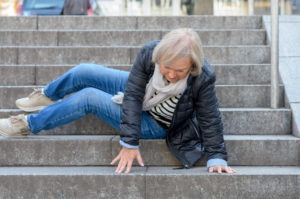Are Slip and Fall Claims Hard to Win?
Slip and fall cases hinge on demonstrating that a property owner was negligent in maintaining their premises, leading to your injury. Unfortunately, many falls are not witnessed, making it challenging to back up your version of events.
Proving negligence relies on demonstrating that the property owner knew or should have known about the risk that led to your fall. The concept of “should have” can be difficult to prove.

Elements of Proving Negligence
Demonstrating negligence is an interconnected process. You must have evidence of all four of the following elements to make a claim:
- The property owner owed you a duty of care
- They were aware or should have been aware of a risk and didn’t mitigate it
- You slipped, fell, and sustained injuries as a result of their inaction
- The fact that you were injured entitles you to damages
For example, if you fell in the grocery store because you tripped on your untied shoelaces, that is not negligence. Likewise, if you fell but did not sustain injuries, the property owner does not owe you damages. You must be injured due to negligence to seek damages.
Knowing When You Are Owed a Duty of Care
Duty of care refers to a person’s responsibility to take reasonable steps to avoid causing harm. On the road, it means drivers obey traffic laws. In medicine, it means the doctor provides adequate treatment. On someone’s property, it means the owner maintains a safe environment. You are owed a duty of care when you use someone’s property legally, such as visiting a friend’s house or patronizing a store.
Examples of failing to uphold a duty of care include:
- Puddles or ice
- Unsecured cords
- Uneven flooring
- Lack of lighting
- Loose railings
- Broken elevators
- Crowded aisles
The difficulty comes into play with the timeline—when exactly did the defect arise, and should the property owner have known?
The Negligent Party’s Awareness of Risk
One of the most common defenses in a slip and fall case is that the property owner did not and/or could not have known about a defect on their premises, and therefore could not have prevented your injuries. While it’s hard to argue with a broken stairwell railing, it’s not as difficult to claim it was an unknown, recent development.
As a result, establishing a timeline of events can be crucial in winning your case, like finding evidence that the defect was present long enough that the property owner should have known about it. For this reason, it is crucial to work with specialized attorneys in building your case instead of going about it on your own. Our personal injury attorneys in Glen Oaks or a Garden City slip and fall personal injury lawyer from our firm can launch a thorough investigation to determine the timeline and assign liability. They have the resources to investigate and talk to contractors and manufacturers, employees, other witnesses, engineering experts, construction specialists, etc. to establish the exact details of your case.
The evidence our team can help compile includes:
- Witness testimony
- Employee statements
- Medical records
- Police reports
- Building inspections
- Prior safety violations
- Photo evidence
- Surveillance footage
That being said, actually obtaining this evidence can be a different story.
Obstacles to Overcome in Your Case
The difficulty of your slip and fall claim will depend on many variables. Some common challenges in proving your case may arise from:
- Not calling emergency services
- Lack of witnesses
- No video surveillance
- The defect itself
The defect that caused your accident may be questioned. Premises liability cases may rely on each court’s decision regarding whether a defect is “trivial.” For instance, there is no concrete rule that a pothole four inches deep is a hazard, but three inches is not. Your case’s details could impact your damages.
Eyewitness Reluctance
Establishing that a property owner should have known of risk can rely on eyewitness testimony. A store clerk may have noticed that a display layout posed a tripping hazard. Likewise, someone who used a poorly lit parking garage might have felt it was a risk.
However, employees may be reluctant to report their employers for fear of retribution, while third-party witnesses may not want to become involved in a lawsuit. Without their testimony, it can be harder to prove when the hazard developed.
Personal Attacks
The other party may claim you contributed to the fall through your own actions. Some common arguments include:
- Wearing improper shoes
- Texting or talking on the phone
- Reckless or improper behavior
- Being under the influence
This tactic’s main goal is to distract from the negligent party’s own mistakes, shifting blame to you. Investigations into your claims may even involve research into your finances and personal history, which can be unsettling and upsetting.
There Is Hope That You Could Secure Justice
Although some concrete proof is hard to come by, you should not give up on your right to pursue damages even if no one saw you fall or the property owner claims to have been unaware of the defect. Because some slip and fall cases are hard to win, you may want to consult a lawyer for more additional support.
At the Law Office of Cohen & Jaffe, LLP we can research and gather evidence to bolster your claim, as well as fight back against arguments from the other side. Don’t let the clock wind down on the three-year statute of limitations imposed by NY CVP § 214. Call our office today at (866) 878-6774 for more.









